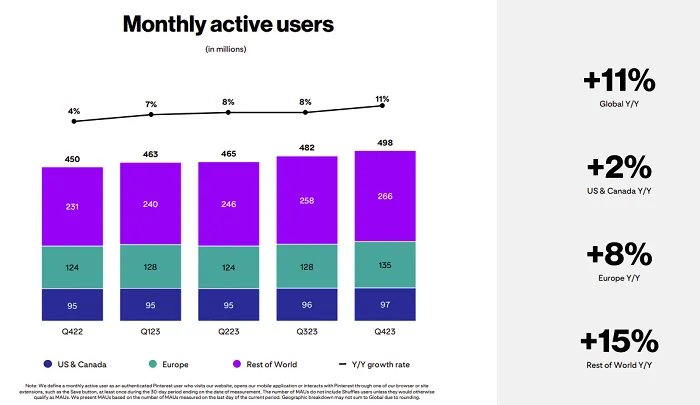Pinterest Adds More Users in Q4, Announces New Google Ad Partnership

Pinterest added more users again in Q4, while also unveiling a new ad partnership with Google, which will help to boost its monetization potential. But its future prospects could also be impacted by the same. Here’s a look at the latest performance update from the app.
First off, on users. Pinterest added 16 million more monthly active users in Q4, taking it up to 498 MAU.

Which continues the platform’s positive growth, moving in the right direction once again after the COVID bump back in 2021.
Amid the global lockdowns, which forced more people into online shopping, Pinterest saw a surge in activity, rising to 478 million users, before losing that momentum, and seeing its audience shrink back down as a result.
That, logically, made market analysts nervous, but now, Pinterest has exceeded that spike, and is continuing to bring in more users, each armed with shopping intent, every quarter.
In fact, that’s now seven consecutive quarters of positive audience growth, which is a strong result, though much like Snapchat, it is also worth highlighting where that growth is coming from, and how that could relate to its broader revenue performance.
As you can see in the above chart, while Pinterest did add 16 million more users overall, it only added a million in North America, its key revenue market.

The positive is that it added more in EU, where its growth has fluctuated, and even declined at one point over the past year, while it’s also still adding more users in other regions, with Brazil and Mexico being key growth areas for the app.
It’s also worth noting that while its EU revenue per user is still nowhere close to what it generates from US users, it did increase by 23% year-over-year for the quarter, and 15% in total for the year.
So while Pinterest does need to do more to monetize this broader audience, things are at least trending in the right direction, though holiday sales figures can skew this somewhat, making it difficult to get an accurate read on relative performance.
But right now, the numbers are all moving up, which is also true on the overall revenue front.

As you can see in this chart, Pinterest generated $981 million in Q4, taking its total over $3 billion for the year. Which, overall, came in lower than expected, which saw shares in the company decline in after-hours trading as a result, though Pinterest CEO Bill Ready did also announce a potentially interesting new partnership with Google, which helped to raise more interest in its future prospects.
On its Q4 earnings call, Ready said that Pinterest has enacted a third party app integration with Google, which will see Pinterest host ads powered by Google, providing another way to bring more shoppable content into the app.
Ready, who once headed Google’s commerce division, says that the new integration will help to improve Pinterest’s monetization processes, and maximize its revenue potential, especially in markets outside the US, where it’s yet to build out its ad tools.
Still, Pinterest’s forward estimates were relatively low. For Q1 2024, Pinterest says that it expects revenue “to be in the range of $690 million to $705 million”, which would be a year-over-year improvement, but a decline on its overall momentum.
Pinterest remains an interesting prospect, as it continues to add more users, and refine its focus on digital shopping experiences. The benefit of Pinterest is exactly that, the majority of its users come to the platform with shopping intent, but at the same time, it remains in competition with bigger marketplaces, like Google and Amazon (whom it also has a third party ad partnership with), which could ultimately limit its potential.
Because while these platforms are happy to use Pinterest as a vehicle for their promotions, that also reduces the direct sales potential for Pinterest itself. Making money from in-stream shopping could be a bigger revenue driver for the app, but instead, it’s looking to facilitate alternative purchase processes, which will still bring in more ad revenue, but could ultimately go against its longer-term ambitions.
Clearly, Pinterest doesn’t see it that way, and it’s hoping that it can generate enough money from these integrations to maximize its potential. But it does seem like it’s partnering with the enemy to some degree, which may not ultimately be to its benefit.
Either way, with a captive audience of 490 million prospective shoppers, it should be a consideration for all brands, at the least to understand what people are engaging with in your niche.


